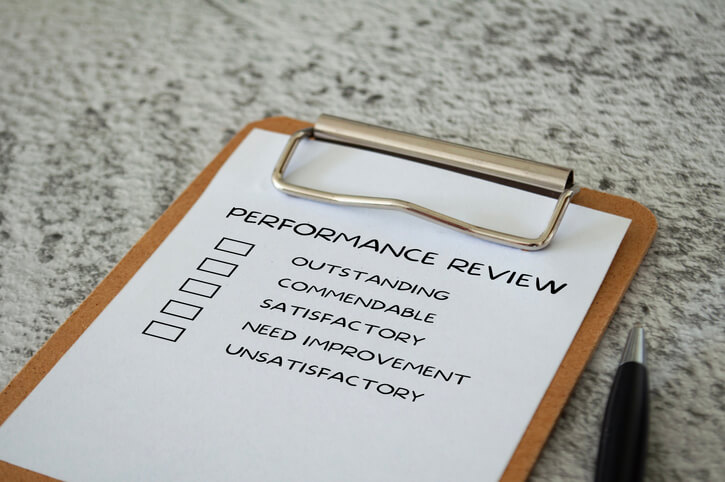Employee reviews can evoke a range of emotions. Excitement often accompanies positive feedback, while worry comes up when feedback is inconsistent.
For managers, the pressure to deliver a review based on anecdotal facts, positive or negative, can be stressful.
Streamlining the review process benefits both managers and employees. A performance review template enhances clarity with a structured evaluation. Explore our expert tips and 16 employee review templates you can use right now for an effective review process.
What is a performance review?
A performance review template is a pre-made document outlining the structure and content of an evaluation. Consider it your guide for assessing an employee’s work performance, providing feedback, and setting goals.
The main goal is to accurately evaluate the employee’s performance and help them form a plan to develop skills needed for their job. These reviews are crucial conversations between managers and employees. They’re meant to show employees what they’re doing well, and identify areas for improvement.
When planning for a review managers often wonder, how do I write a performance review?
The answer: With a performance review template.
Keep your meeting organized, hit all relevant points, and maintain documentation for the future by using a high-quality template.
What are performance review templates?
A performance review template is a pre-made document outlining the structure and content of an evaluation. It acts as a guide for assessing an employee’s work performance, setting goals, and providing feedback.
These templates should be designed to adapt to your specific needs and work with various review types.
Some benefits of using a performance review template include:
- Automation and time-saving
Templates automate performance review cycles, saving time for leaders and simplifying the review process.
- Customization
Tailoring templates to your organization’s needs ensures you gather accurate information that is relevant to specific job requirements.
- Higher quality feedback
Templates offer the structure for clear and actionable feedback, supporting employees’ professional growth.
- Easy documentation
Performance review software, often including templates, consolidates data for easy tracking and report generation on each employee’s progress.
- Increased employee engagement and productivity
Recognizing achievements and addressing issues early through templates enhances team engagement and productivity.
Creating effective employee review templates
The time has come to answer the question— How do I create a performance review template?
Key elements of a good performance review template
To start off, employee review templates should include these essential pieces:
Start with basic information:
- Employee name
- Department
- Position
- Reviewing manager name
- Reviewing manager position
- Date
Include sections for:
- Assessing goals and objectives
- Evaluating specific job-related competencies
- Areas for improvement
- Employee self-assessment
- Clear feedback
A good template encourages open-ended questions that prompt meaningful discussions between managers and employees. Questions requiring a longer response will encourage a comprehensive review of performance.
Finish with signatures from the employee and manager.
Best practices for designing templates
When designing employee review templates, you want them to increase effectiveness and limit distraction. Incorporating simplicity and clarity in the template’s structure makes it easier to use for both managers and employees. Templates should be customized for different industries and roles.
Use clear language and specific criteria for evaluation to provide accurate and actionable feedback. Regularly updating and refining templates based on feedback and changing needs will keep your performance review templates relevant.
Using performance review templates effectively
With a clear picture of what an employee review template is and how to create an effective one, let’s review a quick list of Dos and Don’ts to round out the information.
Do’s
- Do customize templates
- Do provide clear instructions
- Do encourage regular feedback
- Do focus on specific examples
- Do use templates consistently
Don’ts
- Don’t rely solely on generic templates
- Don’t overcomplicate templates
- Don’t neglect training
- Don’t delay feedback
16 performance review templates
General performance review template
This template has the basics, focusing on employee behaviors rated on a 5-point scale and goals:
5-point rating scale: 5– Outstanding, 4– Exceeds expectations, 3- Meets expectations, 2- Needs improvement, 1- Unacceptable
- Adherence to schedules
- Reliability in task completion
- Proficiency in task completion
- Effective client engagement
- Collaborative team player
- Commitment to integrity
- Innovative problem-solving
- Consistent productivity
- Initiative and proactivity
- Effective communication
Quarterly review template (manager review)
Use this template every three months or at the end of each quarter. Allow the employee to complete their self-review before they meet with their reviewing manager.
- Reflection on performance
What were the notable achievements in the employee’s performance during this quarter? - Areas for improvement
In what areas did the employee’s performance have room for improvement over the past quarter? - Setting goals
What specific and measurable goals should the employee strive for in the upcoming quarter? - Planning for success
How can the company assist the employee in measuring the success of their goals for the next quarter? - Alignment of goals
Do the employee’s personal goals align with the company’s broader objectives? - Performance measurement
How would you rate the employee’s performance of set objectives and key performance indicators this quarter? - Adherence to core values
In what ways has the employee demonstrated alignment with the company’s core values during this quarter? - Reflecting on improvement
Based on previous feedback, what steps or actions has the employee taken to improve their performance?
Quarterly review template (self-review)
- Reflection on performance
What were your most notable achievements in your role during the previous quarter? - Areas for improvement
What areas of your work or skills could you improve from the previous quarter? - Setting goals
What are your specific and measurable goals for the next quarter? - Planning for success
How will you track or measure your progress in achieving your goals for the upcoming quarter? - Alignment of goals
Do you feel that your personal goals align with the company’s overall goals and values? - Performance measurement
Rate your overall performance of set objectives and key performance indicators for this quarter. - Adherence to core values
How have you upheld the company’s core values during this quarter? - Reflecting on improvement
How have you implemented feedback received to enhance your performance and skills during this quarter?
Mid-year review template (manager review)
Use this template at the mid-year point. Allow the employee to complete their self-review before they meet with their reviewing manager.
- Reflection on performance
What were the notable achievements in the employee’s performance during the first half of the year? - Areas for improvement
In what areas does the employee’s performance have room for improvement during the first half of the year? - Setting goals
What specific and measurable goals should the employee strive for in the second half of the year? - Planning for success
How can the company assist the employee in measuring the success of their goals for the second half of the year? - Alignment of goals
Do the employee’s personal goals align with the company’s broader objectives? - Performance measurement
How would you rate the employee’s performance of set objectives and key performance indicators during the first half of the year? - Adherence to core values
In what ways has the employee demonstrated alignment with the company’s core values during the first half of the year? - Reflecting on improvement
Based on previous feedback, what steps or actions has the employee taken to improve their performance during the first half of the year?
Mid-year review template (self-review)
- Reflection on performance
What achievements are you proud of during the first half of the year? - Areas for improvement
What areas of your work or skills could you improve from the first half of the year? - Setting goals
What are your specific and measurable goals for the year’s second half? - Planning for success
How will you measure your progress in achieving your goals for the year’s second half? - Alignment of goals
Do you feel that your personal goals align with the company’s overall goals and values? - Performance measurement
Rate your performance concerning set objectives and key indicators during the year’s first half. - Adherence to core values
How have you upheld the company’s core values during the first half of the year? - Reflecting on improvement
How have you implemented feedback received to enhance your performance and skills during the first half of the year?
Annual review template (manager review)
Use this template at the end of the year for a comprehensive performance evaluation.
- Reflection on performance
What were the notable achievements in the employee’s performance throughout the year? - Areas for improvement
In what areas does the employee’s performance have room for improvement over the last year? - Setting goals
What specific and measurable goals did the employee set and achieve during the year? - Planning for success
How did the company assist the employee in achieving their goals during the year? - Alignment of goals
Do the employee’s personal goals align with the company’s broader objectives? - Performance measurement
How would you rate the employee’s overall performance against set objectives and key performance indicators for the year? - Adherence to core values
In what ways has the employee consistently demonstrated alignment with the company’s core values throughout the year? - Reflecting on improvement
Based on previous feedback, what significant steps or actions has the employee taken to enhance their performance during the year?
Annual review template (self-review)
- Reflection on performance
What do you consider to be your most significant achievements in your role throughout the year? - Areas for improvement
What areas of your work or skills do you recognize the need for improvement from the past year? - Setting goals
What were your specific and measurable goals for the year, and which of them did you achieve? - Planning for success
How did you track or measure your progress in achieving your goals throughout the year? - Alignment of goals
How well do you believe your personal goals aligned with the company’s overall goals and values for the year? - Performance measurement
How would you rate your overall performance with objectives and key performance indicators for the year? - Adherence to core values
How have you consistently upheld the company’s core values throughout the year? - Reflecting on improvement
How have you implemented feedback received to enhance your performance and skills during the year?
90-day performance review template
When preparing for a 90-day review, focus on specific and measurable outcomes. Use goals and KPIs discussed during orientation, 30, and 60-day check-ins.
5-point rating scale: 5– Outstanding, 4– Exceeds expectations, 3- Meets expectations, 2- Needs improvement, 1- Unacceptable
- Role expectations
How well does the new hire understand their responsibilities and job expectations? - Learning priorities
How effectively has the new hire grasped and applied key learnings? - Goal-focused tasks
How well has the new hire aligned their short-term goals with the overall team or company objectives? - Contributions
How well has the new hire acclimated and contributed to the team? - Job execution
How effectively has the new hire executed their responsibilities and met job expectations?
Career mapping review template
Use this template to provide feedback to an employee about potential career advancement options within the company based on their performance and your company’s needs:
- Starting job title:
Job description (roles and responsibilities):
Detailed skills or qualifications needed:
Specific and achievable SMART Goals:
Goal 1:
Goal 2:
Goal 3: - Intermediate job title:
Job description (roles and responsibilities):
Detailed skills or qualifications needed:
Specific, achievable goals for transitioning to the intermediate role.
Goal 1:
Goal 2:
Goal 3: - Advanced position job title:
Job description (roles and responsibilities):
Detailed skills or qualifications needed:
Precise, achievable goals for reaching the final position.
Goal 1:
Goal 2:
Goal 3:
Project performance review template
This template allows you to review a project’s effectiveness:
- What was the original project goal? Include the scope of work, deliverables, and timeline.
- Was the original goal met? Include the scope of work, deliverables, and timeline.
- Did the project stay on budget?
- What went well?
- What are areas for improvement?
- What would you do differently?
- Are there any actions you can take now for the future?
Probationary performance review
Use this template when an employee is on probation due to underperformance concerns. Outline specific performance objectives and/or numeric goals that must be accomplished within a deadline. Successfully meeting these objectives will determine the conclusion of the probationary period.
5-point rating scale: 5– Outstanding, 4– Exceeds expectations, 3- Meets expectations, 2- Needs improvement, 1- Unacceptable
Performance assessment:
- Current performance level – Rate the employee’s current performance compared to expectations.
- Specific areas of concern – List the areas where the employee’s performance is lacking and rate them.
Probationary criteria:
- Clarification of probationary goals – Specify numeric goals or tasks the employee must achieve to end the probationary period.
- Employee understanding of probationary expectations – Assess the employee’s comprehension of the goals/tasks required to end the probation (rating 1-5).
Feedback and additional comments:
- Provide feedback on achievements, areas of improvement, and any additional comments or suggestions for the employee’s development.
Peer performance review template
Use this employee feedback template when asking your staff to review a teammate.
Name of teammate being reviewed and their position:
5-point rating scale: 5– Outstanding, 4– Exceeds expectations, 3- Meets expectations, 2- Needs improvement, 1- Unacceptable
- Rate your teammate’s ability to complete tasks on time:
- Rate your teammate’s ability to work and collaborate with the team:
- Rate your teammate’s responsiveness:
- Rate your teammate’s communication skills:
- Rate your teammate’s adaptability and openness to new ideas:
360-degree performance review template
Use this 360-degree performance review to ask employees to provide feedback on their direct manager. It’s critical that employees understand that their feedback will not be shared directly with their manager. Instead, the manager above their manager will review the team’s feedback and share any findings anonymously and as provided by the group, and not from a particular individual. Employees should feel that they can share honest, objective feedback, without fear of retaliation.
- What do you believe are some of your manager’s strengths?
- What do you believe are some of your manager’s weaknesses?
- Do you feel your manager treats all team members fairly?
- Does your manager behave professionally and in accordance with company policies?
- Does your manager provide objective and constructive feedback?
- Do you feel you are welcome to ask questions and share ideas with your manager?
Numeric scale performance review
Use this template for general performance reviews tailored to your specific needs.
5-point rating scale: 5– Outstanding, 4– Exceeds expectations, 3- Meets expectations, 2- Needs improvement, 1- Unacceptable
Rate the following 1-5:
- Communication skills
- Ability to work in a team
- Leadership qualities
- Problem-solving skills
- Time management
- Adaptability to change
- Meets deadlines
- Creativity
- Handles constructive feedback
- Overall professionalism
Weekly 1-on-1s
Here are some questions for weekly 1-on-1 meetings:
- How have you progressed with your tasks since we spoke last week?
- What challenges, if any, have you faced?
- What questions do you have in regards to your upcoming tasks for this week?
- What support do you need from me this week?
- Anything specific you’d like to discuss or share?
Corrective action
When conducting a corrective action plan review, ask specific questions to ensure the plan is effective and addresses issues.
- Identify the root cause of the problem.
- Discuss potential roadblocks to solving the problem.
- Identify expectations moving forward.
- Explain the corrective action.
- Proposed completion date for corrective action.
Make training accessible anywhere with a powerful mobile learning app

FAQs
What should a performance review template include?
- Employee information
- Goals and objectives
- Evaluating specific job-related competencies
- Areas for improvement
- Employee self-assessment
- Clear feedback
- Signatures
How do you write a performance review?
The best way to write a performance review is by starting with a template. Make sure your feedback is objective, comprehensive, specific, and structured.
What do I write in my performance review?
In a performance review, offer a concise overview to guide detailed discussions. Focus on growth areas with specific examples and actionable feedback. Set future goals, summarize past performance, and clarify work expectations. Provide ongoing feedback, emphasize measurable performance, celebrate successes, and view shortcomings as learning opportunities.
What are the 5 words used for rating in a performance review?
5– Outstanding
4– Exceeds expectations
3- Meets expectations
2- Needs improvement
1- Unacceptable
Invest in your most valuable asset
Performance review templates streamline your review process while guiding meaningful discussions between your management and staff. With effective templates, you not only save time but also ensure consistency, clarity, and fairness in assessments.
It’s important that you use this review time to coach your staff, rather than criticize. Have your template ready to enhance communication with your most valuable asset, your people.
Key takeaways
- Templates provide a structured evaluation framework, ensuring consistency and fairness in assessing employee performance.
- Using employee review templates streamlines the process and helps establish consistency in reviews, saving time for both managers and employees by enabling quicker and more efficient evaluations.
- Using templates helps in documenting performance discussions, tracking progress, and maintaining a record of achievements and areas for improvement.
- Performance review templates support ongoing improvement by identifying strengths and areas needing development, fostering a culture of growth within the organization.


